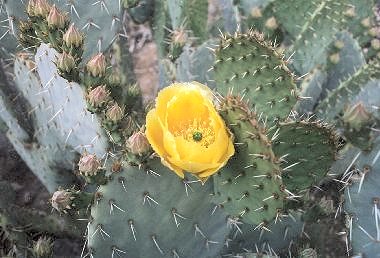Prickly pear range throughout the lower
and middle elevations of the Sonoran desert (the Engelmann's is the most
common prickly pear seen in Arizona) and are an important source of food
 and
shelter for several desert animals. Packrats often build dens at the
base of the plant, which in turn provides protection from some
predators. The pads are eaten by a few animals including javelinas,
jackrabbits and packrats which are able to process the high amounts of
oxalic acid that is contained in them. and
shelter for several desert animals. Packrats often build dens at the
base of the plant, which in turn provides protection from some
predators. The pads are eaten by a few animals including javelinas,
jackrabbits and packrats which are able to process the high amounts of
oxalic acid that is contained in them.
|
Engelmann's Prickly Pear flowers
bloom in May and last only 24 hours. |
People have eaten the fruits (called tunas) of
prickly pear for centuries (which tastes like a combination between a
plum and a watermelon to me). The fruit ripens in large numbers in July
or August and is also eaten by a wide variety of birds, insects and
mammals. You will often piles of the seeds in coyote or bear poop in the
desert. Prickly pears are pollinated by a few species of bees that
collect the pollen to feed developing larvae. |

